
Area Source Rule R307-361 – Architectural Coatings Fact Sheet
Overview
Architectural coatings are paints and other related products used for homes and buildings. The Utah Division of Air Quality, R307-361, was adopted to as part of a package of rules designed to help minimize pollution. The rule applies to any person who supplies, sells, offer to sale, applies, solicits, manufactures, or blends and repackages architectural coatings for use within Box Elder, Cache, Davis, Salt Lake, Tooele, Utah, and Weber Counties.
Container Labeling Requirements
Provide product information on the container including the following.
- Manufactured date or date-code.
- Thinning recommendations.
- Volatile Organic Compound (VOC) content.
- Specific labeling instructions for:
Faux finishing coatings, Industrial maintenance coatings, Rust preventative coatings, Non-flat high-gloss coatings, Specialty primers, Sealers & undercoaters, Reactive penetrating sealers, Reactive penetrating carbonate stone sealers, Stone consolidants, Wood coatings and Zinc rich
Reporting Requirements
Ensure you are following these protocols.
- Maintain a product list, document proof of VOC content for each coating.
- Maintain distribution and sales data.
- Keep records on site to verify the actual VOC content of each coating.
- Ensure records are available within 180 days, upon request.
Exemptions: The VOC limits listed are for coatings as applied (after thinning).
If a coating is recommended for use in more than one of the specialty coating categories listed, the most restrictive (lowest) VOC content limit applies. A coating that does not fit into one of the “specialty coating” categories is considered flat, nonflat, or nonflat-high gloss, as applicable, and the corresponding VOC content limit applies.
Table 1 – VOC Content Limits for Architectural Coatings
| Coating Type | VOC (g/l) | Coating Type | VOC (g/l) | Coating Type | VOC (g/l) |
|---|---|---|---|---|---|
| Flat Coatings | 50 | Non-Flat Coatings | 100 | Non-Flat High Gloss Coatings | 150 |
| Specialty Coatings | |||||
| Aluminum Roofing | 450 | Floor Coatings | 100 | Recycled Coatings | 250 |
| Basement Specialty Coatings | 400 | Form-Release Compounds | 250 | Roof Coatings | 250 |
| Bituminous Specialty Coatings | 400 | Graphic Arts Coatings (sign paints) | 500 | Rust Preventative Coatings | 250 |
| Bituminous Roof Coatings | 270 | High Temperature Coatings | 420 | Shellacs: Clear | 730 |
| Bituminous Roof Primers | 350 | Impacted Immersion Coatings | 480 | Opaque | 550 |
| Bond Beakers | 350 | Industrial Maintenance Coatings | 250 | Specialty Primers, Sealers, and Undercoaters | 100 |
| Calcimine Recoaters | 475 | Low Solids Coatings | 120 | Stains | 250 |
| Concrete Curing Compounds | 350 | Magnesite Cement Coatings | 450 | Stone Consolidant | 450 |
| Concrete/Masonary Sealer | 100 | Mastic Texture Coatings | 100 | Swimming Pool Coatings | 340 |
| Concrete Surface Retarders | 780 | Metallic Pigmented Coatings | 500 | Thermoplastic Rubber Coatings and Mastic | 550 |
| Conjugated Oil Varnish | 450 | Multi-Color Coatings | 250 | Traffic Marking Coatings | 100 |
| Conversion Varnish | 725 | Nuclear Coatings | 450 | Tub and Tile Refinish | 420 |
| Driveway Sealers | 50 | Pre-Treatment Wash Primers | 420 | Waterproofing Membranes | 250 |
| Dry Fog Coatings | 150 | Primers, Sealers, and Undercoaters | 100 | Wood Coating | 275 |
| Faux Finishing Coatings | 350 | Reactive Penetrating Sealer | 350 | Wood Preservatives | 350 |
| Fire Resistive Coatings | 350 | Reactive Penetrating Carbonate Stone Sealer | 500 | Zinc-Rich Primer | 340 |
2020 Spring Burn Permit Summary
The Utah Division of Air Quality requirement, R307-202, was adopted as a package of rules that regulate open burning activities and help minimize emissions and ensure that the National Ambient Air Quality Standards are met. Recent modifications to these rules change the open burn periods and include a statewide requirement to obtain a permit from the local county or municipal fire authority prior to burning.
The rule requires applicants to complete the open burn permit application prior to igniting an open burn. After the application process is completed, a copy of the application is sent electronically to the county or municipal fire authority having jurisdiction in the area where the open burning will take place. Though the application process is the same statewide, some county and municipal fire authorities require additional steps to be taken prior to issuing a valid open burn permit. Applicants should contact their local fire authority once the open burn permit application is complete to ensure all local open burning requirements are met.
The Rule allows open burning of clippings, bushes, plants, and pruning’s from trees to property and residential clean-up activities, provided that the following conditions have been met.
Permits may be issued between March 1 and May 30 and between September 15 and November 15 in the counties of Washington, Kane, San Juan, Iron, Garfield, Beaver, Piute, Wayne, Grand, and Emery. Permits may be issued between March 30 and May 30 and between September 15 and October 30 in all other areas of the state.
The 2020 Spring Burn season comprised of the following open burn and agricultural permits issued per county:
Beaver County: 5
Box Elder County: 389
Cache County: 1,822
Carbon County: 57
Davis County: 13
Duchesne County: 1
Emery County: 354
Grand County: 512
Iron County: 496
Juab County: 145
Morgan County: 222
Sevier County: 487
Summit County: 292
Tooele County: 436
Uintah County: 211
Utah County: 1,918
Washington County: 57
Wayne County: 64
Weber County: 2,341

